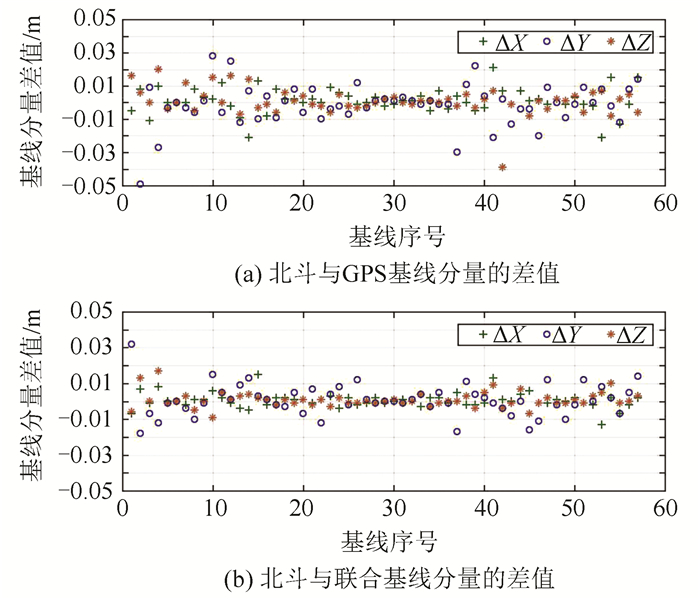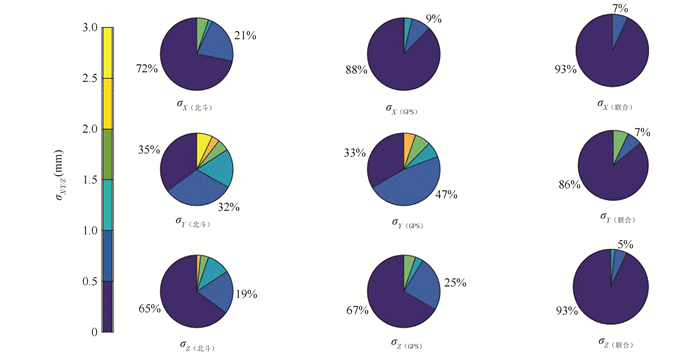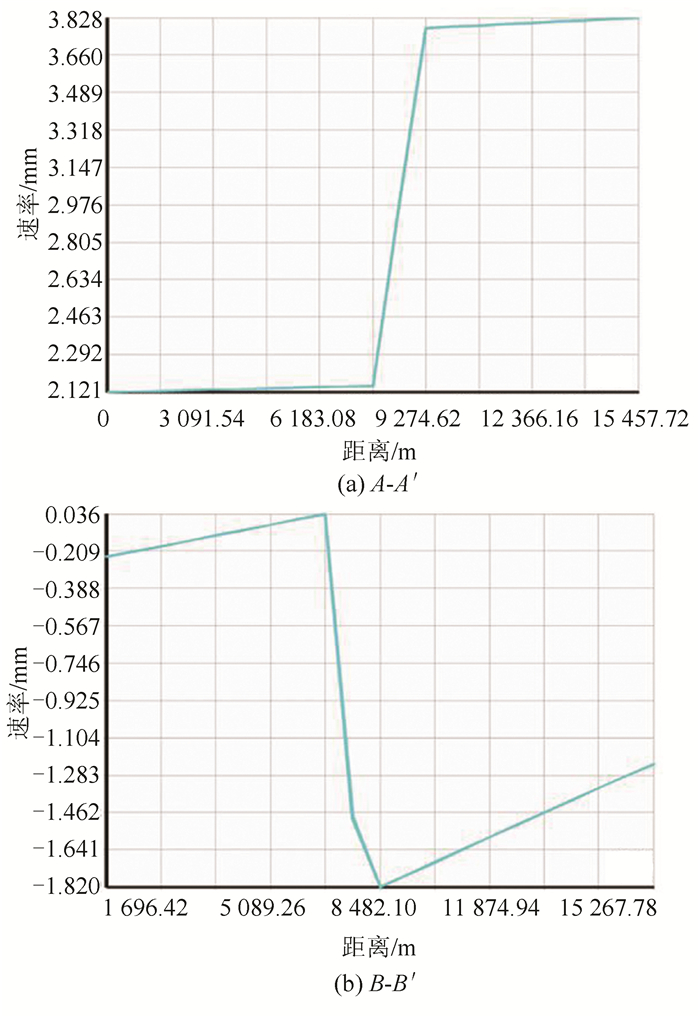-
摘要: 依据渭河盆地活动构造特征及深部地层结构,以高精度GPS成果为边界条件,构建了区域三维有限元模型,并将模拟断裂运动性质及区域构造应力场,与地质地球物理的结果对比检验了模型模拟结果合理性。数值模拟结果更加精细地揭示出,陇县-马昭与韩城-华县断裂是渭河盆地中部与东、西部构造应力场差异的明显分界带,两条断裂夹挟的盆地中部区域是拉张应力(NW-SE向)集中带,陇县-马昭断裂以西则呈显著挤压应力(近E-W向),韩城-华县断裂以东以NE-SW向挤压应力为主;而礼泉-蒲城-合阳断裂又为盆地中部区域南、北两侧构造应力场差异分界带,断裂南侧较北侧呈现出更显著的NW-SE向拉张应力,该特征与断裂南侧构造地裂缝较北侧更为发育相对应。Abstract: Based on the tectonic and the deep geological strata structure of the Weihe Basin, the three-dimensional (3D) finite element dynamic model was established by using the high-precision GPS monitoring data as boundary conditions. We further compared the movement property of faults and focal tectonic stress field simulated by the 3D model with the geological survey results and focal mechanism. The results of numerical simulation detailed reveal that the Longxian-Mazhao and Hancheng-Huaxian faults are the obvious difference boundaries of the tectonic stress field. The middle part where between the two faults is the concentration zone of tensile stress in the NW-SE direction, on the west side of the Longxian-Mazhao fault presents significant compression stress in the E-W direction, while on the east side of the Hancheng-Huaxian fault mainly presents compression stress in the NE-SW direction. The Pucheng-Liquan-Heyang fault is also the obvious difference boundaries divided the tectonic stress field of the middle part of Weihe Basin into two parts. The south side shows more significant tensile stress in the NW-SE direction compared with the north side of this fault. That may be the tectonic dynamic mechanism for the ground fissure more developed in the south side than the north side.
-
目前,北斗导航卫星系统(BDS)已实现局域覆盖,随着系统建设的不断完善和应用的不断拓展,与之相关的各类数据处理软件的开发成为重要的研究内容。因此,自主开发北斗高精度数据处理软件,成为发展高精度位置服务的迫切任务[1-8]。因北斗导航卫星系统与GPS在星座构造、坐标框架、时间系统、信号频率等方面具有明显差异[9-15],现有的高精度GPS数据处理软件无法直接处理北斗数据。本文针对北斗高精度数据处理的系统设计、数据流、功能模块及高精度算法实现等进行了研究,研制开发了一套高精度北斗基线解算软件BGO(BeiDou Navigation Satellite System/Global Positioning System Office),并将其用于高速铁路高精度控制测量建网。通过与商业软件TGO(Trimble Geomatics Office)和TBC(Trimble Business Center),及高精度科研软件Bernese进行对比测试、性能分析,验证了该软件的正确性和有效性。
1 系统的设计与模块算法的实现
1.1 系统设计与数据流分析
北斗和GPS基线解算软件主要包含北斗基线处理、GPS基线处理及联合基线处理3大模块。各模块间相互独立,但使用相同的数据结构,且数据流基本一致。数据处理流程如图 1所示。
基线解算之前,需选择有效双频观测数据,具体包含低高度角卫星剔除、观测值粗差剔除、星历未获取观测数据剔除等。剔除质量较差的观测数据可通过可视化的方式实现。通过双频数据组合有效消除电离层延迟影响,伪距消电离组合能算出测站精确至10 m内的概略位置,从而形成网络拓扑图,便于用户查看站点的平面分布。基线解算时,北斗与GPS独立系统数据处理算法相同;联合处理需选择统一的坐标和时间框架,随着多余观测数的增加,还需设置合理的模糊度固定限值。基线解算后,进行网平差,应剔除不合格基线,直至平差结果满足要求。
1.2 高精度基线解算算法实现
高精度基线解算利用双差观测量建立误差方程,北斗双差观测量构造如式(1):
$$ \mathit{\Delta} \nabla L^{{C_m}{C_n}}_{{S_i}{S_j}} = \left( {L^{{C_n}}_{{S_j}} - L^{{C_n}}_{{S_i}}} \right) - \left( {L^{{C_m}}_{{S_j}} - L^{{C_m}}_{{S_i}}} \right) $$ (1) 式中,Δ▽L表示双差观测量;Si和Sj表示任意站点;Cm和Cn表示任意北斗卫星。
依据式(1)构建的双差观测量,建立误差方程,如式(2):
$$ \left[ \begin{array}{l} \mathit{\Delta} \nabla \boldsymbol{\varPhi} \\ \mathit{\Delta} \nabla \boldsymbol{P} \end{array} \right] = \boldsymbol{BX} + \boldsymbol{A}\mathit{\Delta} \nabla \boldsymbol{N} + \boldsymbol{V} $$ (2) 式中,Δ▽Φ和Δ▽P分别表示卫星载波相位和伪距双差观测量;X表示基线向量;Δ▽N表示双差整周模糊度;B和A为系数阵;V为残差向量。
利用式(2)构建的误差方程,解算基线向量和双差整周模糊度浮点解。利用LAMBAD方法[16, 17]固定双差整周模糊度后去除。再利用载波相位观测值获取高精度基线向量结果。基线解算过程中,主要利用抗差估计的切比雪夫多项式拟合法[18]及MW-GF组合法[19]探测与修复周跳。
对北斗和GPS双系统基线解算,只需将各系统的双差观测量误差方程叠加后平差计算,即可实现双系统联合基线解算。但需注意,星间差分需选择同一系统卫星,否则会引入系统间信号硬件延迟[20],影响双差整周模糊度的固定。另外,北斗和GPS在时间框架、坐标框架等存在一定差异,双系统联合解算需保证框架的统一。
北斗和GPS时间转换公式如式(3):
$$ {t_C} = {t_G}-14\;{\rm{s}} $$ (3) 式中,tC和tG分别表示北斗时和GPS时,两者均为原子时,起算原点不同[13]。
北斗和GPS坐标转换公式如式(4):
$$ \begin{array}{c} \left[ {\begin{array}{*{20}{c}} {{X_C}}\\ {{Y_C}}\\ {{Z_C}} \end{array}} \right] = \left[ {\begin{array}{*{20}{c}} {{X_G}}\\ {{Y_G}}\\ {{Z_G}} \end{array}} \right] + \left[ {\begin{array}{*{20}{c}} {{T_X}}\\ {{T_Y}}\\ {{T_Z}} \end{array}} \right] + \\ \left[ {\begin{array}{*{20}{c}} D&{ - {R_Z}}&{{R_Y}}\\ {{R_Z}}&D&{ - {R_X}}\\ { - {R_Y}}&{{R_X}}&D \end{array}} \right]\left[ {\begin{array}{*{20}{c}} {{X_G}}\\ {{Y_G}}\\ {{Z_G}} \end{array}} \right] \end{array} $$ (4) 式中,北斗坐标(XC,YC,ZC)与GPS坐标(XG,YG,ZG)可通过七参数TX、TY、TZ、D、RX、RY、RZ进行转换。北斗CGCS2000坐标系采用ITRF97框架2000历元的坐标和速度场,当前GPS WGS84坐标和ITRF08基本一致。因此,可利用ITRF97框架2000历元与ITRF08间转换的七参数(ITRF网站公布)实现北斗与GPS坐标框架的统一[11, 12]。
2 BGO数据处理实例与性能测试
2.1 高速铁路CPI控制网基线解算
处理高速铁路CPI控制网时,通过读取观测文件和星历文件,单点定位生成控制网的基线网络拓扑图,如图 2所示。基线解算前,设置相关参数包括卫星截止高度角、误差限差参数、框架、对流层模型、电离层模型、模糊度Ratio值、同步最小观测历元数等。设置完成后,可选择北斗、GPS、联合3种模式进行基线解算。基线解算完成后,软件界面中将显示解算的基线分量及其精度,并可显示残差向量检核基线解算效果。
2.2 BGO、TGO、Bernese软件处理GPS基线结果比较
为了测试BGO解算GPS基线的正确性,将其与TGO和Bernese软件处理结果进行了比较,得到57条GPS基线(基线最长6 667 m,最短446 m)的比较结果,如图 3所示。
图 3(a)、3(b)分别表示BGO软件与TGO、Bernese软件处理GPS基线分量的差值ΔX、ΔY、ΔZ。图 3(a)中,BGO和TGO有52条基线在X、Y、Z方向的分量差值均在2 cm内,有48条基线各分量差值在mm级。TGO解算少量基线验后方差分量超限,与BGO基线分量差值较大。图 3(b)中,BGO和Bernese有55条基线在X、Y、Z方向的分量差值均在2 cm内,有49条基线各分量差值在mm级。
图 4(a)~4(c)分别表示BGO、TGO、Bernese软件处理GPS基线的内符合精度σX、σY、σZ(BGO、TGO、Bernese软件基线解算精度分别精确至0.1 mm、1 mm和0.1 mm)。整体上,约90%的基线3个软件的解算精度相当。
2.3 BGO、TBC软件处理北斗与GPS联合基线结果
为了测试BGO解算北斗与GPS联合基线的性能,本文选用美国Trimble的商业软件TBC与之进行比较。同上57条基线,每条基线观测数据均包含北斗与GPS观测数据。图 5展示了BGO和TBC处理北斗与GPS联合基线分量的差值ΔX、ΔY、ΔZ。图 5可见,98%的基线分量差值分布在mm级,表明BGO软件处理联合基线能达到与TBC软件相当的水平。另外,两者内符合精度绝大部分均在mm级,故图 5中未加以比较。
由此可知,BGO软件处理GPS基线、北斗与GPS联合基线的内外符合精度能达到TGO、Bernese、TBC相当的水平。因此,以BGO软件处理GPS、北斗与GPS联合基线结果为参考值,分析该软件处理北斗基线结果的正确性和可靠性,如图 6和图 7所示。图 6比较了北斗与GPS、联合基线分量的差值,图 7比较了北斗、GPS、联合基线解算的内符合精度。
图 6(a)表示BGO软件处理北斗与GPS基线分量的差值ΔX、ΔY、ΔZ,其中有43条基线在X、Y、Z方向上的分量差值Δx、Δy、Δz在2 cm内,有31条基线在X、Y、Z方向上的分量差值在mm级。图 6(b)表示BGO软件处理北斗与联合基线分量的差值,其中有54条基线在X、Y、Z方向上的分量差值在2 cm内,有38条基线在X、Y、Z方向上的分量差值在mm级(图 6中第6条基线北斗为浮点解,各分量差值结果较大,图中置为0)。
图 7中,93%的联合基线在X、Y、Z方向上的分量精度分别优于0.5 mm、1 mm、0.5 mm;约90%的北斗基线和95%的GPS基线在X、Y、Z方向上的分量精度分别优于1 mm、2 mm、1 mm。由北斗、GPS、联合基线3者精度比较可知,在北斗试运行阶段,GPS基线内符合精度略优于北斗,北斗与GPS联合系统基线内符合精度明显高于独立系统。
2.4 BGO基线网平差及其精度分析
BGO具备网平差功能,根据网平差后的基线分量改正数、相对中误差、点位精度等判断基线解算结果的可靠性。对上述解算的北斗、GPS、联合基线分别进行无约束网平差。
北斗、GPS、联合基线无约束网平差的平差改正数δX、δY、δZ绝大部分在±1 cm内,如图 8(a)~8(c)所示。最弱边相对中误差优于5.5 ppm(规范限值),具体见表 1。据图 8、表 1及《高速铁路工程测量规范》[21]可知,BGO能合理稳定地解算北斗、GPS及联合基线,解算结果中的基线向量改正数、最弱边相对中误差、最弱点点位精度均满足CPI控制测量要求,各系统解算均能精确获得24个CPI控制点坐标。
表 1 GPS、北斗、联合无约束平差结果统计Table 1. The Statistics of GPS, BDS and BDS/GPS Combined Unconstrained Adjustment Results解算模式 独立基线 多余观测数 控制点个数 最弱边相对中误差/ppm 最弱点点位精度/mm GPS 55 66 24 3.6 23.6 北斗 51 57 24 3.1 26.9 联合 57 72 24 3.7 17.9 3 结语
本文系统地研究了北斗与GPS联合基线解算的算法,自主开发了北斗高精度基线解算软件BGO。通过实测高铁CPI控制网的数据处理测试表明:软件能进行高精度地处理北斗与GPS数据, 以及北斗与GPS联合数据处理;GPS基线解算性能与天宝TGO软件相当,能达到与Bernese软件一致的精度;北斗与GPS基线处理能达到与TBC相当的水平。BGO最大的优势在于能对北斗和GPS进行联合解算,从而提高北斗或GPS单系统的基线解算合格率和精度。经高速铁路CPI控制网实例测试,证明该软件处理基线结果可用于高精度北斗和GPS测量控制网的数据处理。
-
表 1 渭河盆地及其周边区域各介质层物性参数表
Table 1 The Mechanical Parameters of Each Medium Body of Weihe Basin and Its Surrounding Areas
介质体名称 上地壳 中地壳 下地壳 上地幔 弹性模量
E/GPa泊松比
ν弹性模量
E/GPa泊松比
ν弹性模量
E/GPa泊松比
ν弹性模量
E/GPa泊松比
ν鄂尔多斯地块 29.72 0.25 40.75 0.26 48.05 0.28 82.77 0.31 华北地块西缘 26.01 0.26 34.89 0.27 44.71 0.29 77.42 0.31 青藏地块东缘 31.87 0.25 35.41 0.26 47.51 0.28 79.12 0.31 华南地块北缘 27.01 0.25 35.34 0.26 44.51 0.28 78.03 0.31 渭河盆地 25.00 0.26 32.00 0.27 42.00 0.30 76.00 0.32 表 2 模型模拟断裂运动性质与地质调查结果对比表
Table 2 Comparison of the Faults Activities Nature Between the Modeling and the Geological Survey
断裂名称 地质调查断裂运动性质 模型模拟断裂运动性质 渭河断裂 左旋正断型 左旋 秦岭北缘断裂 左旋正断型 左旋 口镇-关山断裂 左旋正断型 左旋 余下-铁炉子断裂 左旋正断型 左旋 岐山-乾县断裂 右旋正断型 右旋 礼泉-蒲城-合阳断裂 右旋正断型 右旋 华山山前断裂 左旋正断型 左旋 白水-合阳断裂 右旋正断型 右旋 固关-龟川寺断裂 左旋正断型 左旋 固关东-虢镇断裂 左旋正断型 左旋 陇县-马召断裂 左旋正断型 左旋 泾阳-蓝田断裂 左旋正断型 左旋 长安-临潼-白水断裂 右旋正断型 右旋 韩城-华县断裂 右旋正断型 右旋 -
[1] 彭建兵, 张俊, 苏生瑞, 等.渭河盆地活动断裂与地质灾害[M].西安:西北大学出版社, 1992 Peng Jianbing, Zhang Jun, Su Shengrui, et al. The Activity Faults and Ground Fissures Disaster of Weihe Basin[M]. Xi'an:Northwestern University Press, 1992
[2] 戴王强, 任隽, 赵小茂, 等. GPS初步揭示出的渭河盆地及边邻地区地壳水平运动特征[J].地震学报, 2004, 26(3):256-260 http://www.cqvip.com/QK/93548X/200403/9959520.html Dai Wangqiang, Ren Jun, Zhao Xiaomao, et al. Characteristics of Horizontal Crustal Movement in Weihe Basin and Adjacent Zones by GPS Observation[J]. Acta Seismologica Sinica, 2004, 26(3):256-260 http://www.cqvip.com/QK/93548X/200403/9959520.html
[3] 张永志, 段虎荣, 王卫东, 等.用GPS数据研究汾渭盆地构造应力场变化[J].大地测量与地球动力学, 2011, 31(2):44-47 http://www.oalib.com/paper/1554481 Zhang Yongzhi, Duan Hurong, Wang Weidong, et al. Tectonic Stress Variation of Fenwei Basin Derived from GPS Data[J]. Journal of Geodesy and Geodynamics, 2011, 31(2):44-47 http://www.oalib.com/paper/1554481
[4] 冯希杰, 戴王强.渭河盆地断层活动的横向迁移[J].地震学报, 2004, 26(2):174-182 http://kns.cnki.net/KCMS/detail/detail.aspx?filename=dzxb200402006&dbname=CJFD&dbcode=CJFQ Feng Xijie, Dai Wangqiang. Lateral Migration of Fault Activity in Weihe Basin[J]. Acta Seismologica Sinica, 2004, 26(2):174-182 http://kns.cnki.net/KCMS/detail/detail.aspx?filename=dzxb200402006&dbname=CJFD&dbcode=CJFQ
[5] 师亚芹, 冯希杰, 戴王强, 等.渭河断裂西安段的展布及其结构特征[J].地震学报, 2008, 30(6):634-647 http://www.cqvip.com/QK/93548X/200806/28962934.html Shi Yaqin, Feng Xijie, Dai Wangqiang, et al. Distribution and Structural Characteristics of the Xi'an Section of the Weihe Fault[J]. Acta Seismologica Sinica, 2008, 30(6):634-647 http://www.cqvip.com/QK/93548X/200806/28962934.html
[6] 瞿伟, 张勤, 王庆良, 等.渭河盆地现今地壳水平形变特征及区域构造活动性[J].武汉大学学报·信息科学版, 2011, 36(7):830-834 http://ch.whu.edu.cn/CN/abstract/abstract585.shtml Qu Wei, Zhang Qin, Wang Qingliang, et al. Research on Present Crustal Horizontal Deformation Feature of Weihe Basin and its Tectonic Activity[J]. Geomatics and Information Science of Wuhan University, 2011, 36(7):830-834 http://ch.whu.edu.cn/CN/abstract/abstract585.shtml
[7] 张勤, 瞿伟, 彭建兵, 等.渭河盆地地裂缝群发机理及东、西部地裂缝分布不均衡构造成因研究[J].地球物理学报, 2012, 55(8):2589-2597 doi: 10.6038/j.issn.0001-5733.2012.08.010 Zhang Qin, Qu Wei, Peng Jianbing, et al.Research on Tectonic Causes of Numerous Ground Fissures Development Mechanism and its Unbalance Distribution Between Eastern and Western of Weihe Basin[J]. Chinese J. Geophys., 2012, 55(8):2589-2597 doi: 10.6038/j.issn.0001-5733.2012.08.010
[8] 赵超英, 张勤, 朱武, 等.采用TerraSAR-X数据监测西安地裂缝形变[J].武汉大学学报·信息科学版, 2012, 37(1):81-85 http://ch.whu.edu.cn/CN/abstract/abstract93.shtml Zhao Chaoying, Zhang Qin, Zhu Wu, et al. Monitoring on Xi'an Ground Fissures Deformation with TerraSAR-X Data[J]. Geomatics and Information Science of Wuhan University, 2012, 37(1):81-85 http://ch.whu.edu.cn/CN/abstract/abstract93.shtml
[9] 任隽, 彭建兵, 王夫运, 等.渭河盆地及邻区地壳深部结构特征研究[J].地球物理学报, 2012, 55(9):2939-2947 doi: 10.6038/j.issn.0001-5733.2012.09.013 Ren Jun, Peng Jianbing, Wang Fuyun, et al. The Research of Deep Structural Features of Weihe Basin and Adjacent Areas[J]. Chinese J. Geophys, 2012, 55(9):2939-2947 doi: 10.6038/j.issn.0001-5733.2012.09.013
[10] 滕吉文.固体地球物理学概论[M].北京:地震出版社, 2003 Teng Jiwen. Introduction to Solid Earth Geophysics[M]. Beijing:Seismological Press, 2003
[11] Huang Zhongxian, Su Wei, Peng Yanju, et al. Rayleigh Wave Tomography of China and Adjacent Regions[J]. Journal of Geophysical Research Atmosphere, 2003, 108(B2):345-366 http://adsabs.harvard.edu/abs/2003JGRB..108.2073H
[12] 刘峡. 华北地区现今地壳运动及形变动力学数值模拟[D]. 合肥: 中国科技大学, 2007 http://cdmd.cnki.com.cn/Article/CDMD-10358-2007097329.htm Liu Xia. Dynamic Numerical Simulation of the Contemporary Crustal Movement and Deformation in North China[D]. Hefei:University of Science and Technology of China, 2007 http://cdmd.cnki.com.cn/Article/CDMD-10358-2007097329.htm
[13] 张培震, 甘卫军, 沈正康, 等.中国大陆现今构造作用的地块运动和连续变形耦合模型[J].地质学报, 2005, 79(6):748-756 http://www.cqvip.com/QK/95080X/2005006/20877269.html Zhang Peizhen, Gan Weijun, Shen Zhengkang, et al. A Coupling Model of Rigid-Block Movement and Continuous Deformation:Patterns of the Present-day Deformation of China's Continent and its Vicinity[J]. Acta Geologica Sinica, 2005, 79(6):748-756 http://www.cqvip.com/QK/95080X/2005006/20877269.html
[14] 柳畅, 石耀霖, 郑亮, 等.三维黏弹性数值模拟华北盆地地震空间分布于构造应力积累关系[J].地球物理学报, 2012, 55(12):3942-3957 doi: 10.6038/j.issn.0001-5733.2012.12.007 Liu Chang, Shi Yaolin, Zheng Liang, et al. Relation Between Earthquake Spatial Distribution and Tectonic Stress Accumulation in the North China Basin Based on 3D Visco-Elastic Modelling[J]. Chinese J. Geophys., 2012, 55(12):3942-3957 doi: 10.6038/j.issn.0001-5733.2012.12.007
[15] 王卫东. 西安地裂缝形成的区域稳定动力学背景研究[D]. 西安: 长安大学, 2010 http://cdmd.cnki.com.cn/Article/CDMD-11941-1011186704.htm Wang Weidong. Study on the Regional Stability Dynamical Background in the Forming of Xi'an Ground Fissures[D]. Xi'an:Chang'an University, 2010 http://cdmd.cnki.com.cn/Article/CDMD-11941-1011186704.htm
[16] 谢振乾, 方继安, 田西堂, 等.渭河盆地构造应力场演变及盆地形成机制分析[J].西安地质学院学报, 1991, 12(1):45-52 http://kns.cnki.net/KCMS/detail/detail.aspx?filename=xagx199101007&dbname=CJFD&dbcode=CJFQ Xie Zhenqian, Fang Ji'an, Tian Xitang, et al. The Evolution of the Structural Stress Field and Analysis of the Formation Mechanism in the Weihe Basin[J]. Journal of Xi'an College of Geology, 1991, 12(1):45-52 http://kns.cnki.net/KCMS/detail/detail.aspx?filename=xagx199101007&dbname=CJFD&dbcode=CJFQ
-
期刊类型引用(6)
1. 柯文清 ,陈业滨 ,赵志刚 ,韩德志 ,郭仁忠 . 基于文献计量的新世纪地图可视化研究演变和热点分析. 地理与地理信息科学. 2025(01): 15-23 .  百度学术
百度学术
2. 于峰一泽,汤国安,陆鼎阳,林晓芬,胡光辉,沈婕,吴明光. 语言学视角下的地图演化. 地理学报. 2024(01): 171-186 .  百度学术
百度学术
3. 韩德志,郭仁忠,陈业滨,赵志刚,柯文清. 基于可视化维度理论的泛地图知识推荐方法. 地球信息科学学报. 2024(01): 110-120 .  百度学术
百度学术
4. 刘强,刘金花,王磊斌,陈鑫,赵志斌,赵晓艳,李英奎. 使用虚拟现实技术提高冰川地貌表达维度的研究. 冰川冻土. 2024(03): 1087-1098 .  百度学术
百度学术
5. 邓志钢,郭仁忠,陈业滨,马丁,赵志刚,朱维. 面向轨迹可视化的泛地图表达维度关联方法及应用. 测绘通报. 2024(11): 56-60+96 .  百度学术
百度学术
6. 柯婷,杨品福,任福,李连营,杨晨. 内河航行参考图地图符号形式化表达. 地理空间信息. 2024(12): 102-105 .  百度学术
百度学术
其他类型引用(4)






 下载:
下载:
















